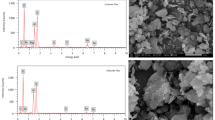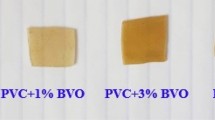Abstract
In the present study, radiation shielding properties of two glassy composite materials that are widely used in electronics, photovoltaic applications, and sensor technology, were investigated in the photon energy range from 15 keV to 15 MeV. The materials chosen were (ITO)/V2O5/B2O3 and ZnO/V2O5/B2O3 including various concentrations of B2O3. Radiation interaction was simulated and shielding parameters calculated by means of the MCNP and BXCOM codes. More specifically, buildup factors, effective electron density (\(N_{\text{eff}}\)) and effective atomic number (\(Z_{\text{eff}}\)) were calculated with BXCOM, while mass attenuation coefficients (\(\mu /\rho\)), half-value layer (HVL) and tenth-value layer (TVL) values were calculated with MCNP. The results were compared with those obtained with the WinXCOM code, for validation. Acceptable and preferable results were obtained for both composites as alternative to other glassy shielding materials. The composite including ITO showed better shielding properties than the composite including ZnO. In terms of radiation shielding, both composites turned out to be better than concrete and close to lead.









Similar content being viewed by others
References
Afyon S, Krumeich F, Mensing C, Borgschulte A, Nesper R (2014) New high capacity cathode materials for rechargeable Li-ion batteries: vanadate-borate glasses. Sci Rep 4:7113
Briesmeister JF (2000) MCNPTM—a general Monte Carlo N-particle transport code. Version 4C, LA-13709-M, Los Alamos National Laboratory, p 2
Chanthima N, Kaewkhao J, Limkitjaroenporn P, Tuscharoen S, Kothan S, Tungjai M, Limsuwan P (2017) Development of BaO–ZnO–B2O3 glasses as a radiation shielding material. Radiat Phys Chem 137:72–77
Chilton AB, Shultis JK, Faw RE (1984) Principles of radiation shielding. Prentice Hall, New Jersey, pp 90–92
Demirbay T, Çağlar M, Karabul Y, Kılıç M, İçelli O, Özdemir ZG (2019) Availability of water glass/Bi2O3 composites in dielectric and gamma-ray screening applications. Radiat Eff Defects Solids 174(5–6):419–434
Dogra M, Singh KJ, Kaur K, Anand V, Kaur P (2017) Gamma ray shielding and structural properties of Bi2O3–B2O3–Na2WO4 glass system. Univ J Phys Appl 11(5):190–195
Dong M, Xue X, Yang H, Liu D, Wang C, Li Z (2016) Novel comprehensive utilization of vanadium slag: as gamma ray shielding material. J Hazard Mater 318:751–757
Elizabeth U, Uno EO, Sobechukwu MC, Olusunle SOO, Emeka OC (2016) The optical and electrical properties of boron doped zinc oxide prepared by electrostatic spray deposition. Am J Energy Sci 3(4):21–25
Eyecioğlu O, Karabul Y, El-Khayatt AM, İçelli O (2016) ZXCOM: a software for computation of radiation sensing attributes. Radiat Eff Defects Solids 171(11–12):965–977
Eyecioğlu Ö, El-Khayatt AM, Karabul Y, Çağlar M, Toker O, İçelli O (2019) BXCOM: a software for computation of radiation sensing. Radiat Eff Defects Solids 174:1–13
Gandhi Y, Purnachand N, Sudhakar KSV, Satyanarayana T, Veeraiah N (2010) Influence of modifier oxides on some physical properties of antimony borate glass system doped with V2O5. Mater Chem Phys 120(1):89–97
Gezgin SY, Kılıç HŞ (2019) The electrical characteristics of ITO/CZTS/ZnO/Al and ITO/ZnO/CZTS/Al heterojunction diodes. Optic 182:356–371
Ghosh M, Raychaudhuri AK (2009) Field induced reversible control of visible luminescence in ZnO nanostructures. arXiv preprint arXiv:0903.3735
Gull N, Khan SM, Munawar MA, Shafiq M, Anjum F, Butt MTZ, Jamil T (2015) Synthesis and characterization of zinc oxide (ZnO) filled glass fiber reinforced polyester composites. Mater Des 67:313–317
Issa SA (2016) Effective atomic number and mass attenuation coefficient of PbO–BaO–B2O3 glass system. Radiat Phys Chem 120:33–37
Karabul Y, Susam LA, İçelli O, Eyecioğlu Ö (2015) Computation of EABF and EBF for basalt rock samples. Nucl Instrum Methods Phys Res Sect A 797:29–36
Kavanoz HB, Akçalı Ö, Toker O, Bilmez B, Çağlar M, İçelli O (2019) A novel comprehensive utilization of vanadium slag/epoxy/antimony trioxide ternary composite as gamma ray shielding material by MCNP 6.2 and BXCOM. Radiat Phys Chem 165:108446
Kavaz E, Ekinci N, Tekin HO, Sayyed MI, Aygün B, Perişanoğlu U (2019) Estimation of gamma radiation shielding qualification of newly developed glasses by using WinXCOM and MCNPX code. Prog Nucl Energy 115:12–20
Kiyani A, Karami AA, Bahiraee M, Moghadamian H (2013) Calculation of gamma buildup factors for point sources. Adv Mater Res 2(2):93–98
Khalkhali Z, Hamnabard Z, Qazvini SSA, Baghshahi S, Maghsoudipour A (2012) Preparation, phase formation and photoluminescence properties of ZnO–SiO2–B2O3 glasses with different ZnO/B2O3 ratios. Opt Mater 34(5):850–855
Khan FM, Gibbons JP (2014) Khan’s the physics of radiation therapy. Lippincott Williams & Wilkins, Philadelphia
Kumar A, Zhou C (2010) The race to replace tin-doped indium oxide: which material will win? ACS Nano 4(1):11–14
Lee YI, Lee JH, Hong SH, Park Y (2004) Li-ion conductivity in Li2O–B2O3–V2O5 glass system. Solid State Ion 175(1–4):687–690
McCaffrey JP, Shen H, Downton B, Mainegra-Hing E (2007) Radiation attenuation by lead and nonlead materials used in radiation shielding garments. Med Phys 34(2):530–537
Özdemir T, Akbay IK, Uzun H, Reyhancan IA (2016) Neutron shielding of EPDM rubber with boric acid: mechanical, thermal properties and neutron absorption tests. Prog Nucl Energy 89:102–109
Qazvini SSA, Hamnabard Z, Khalkhali Z, Baghshahi S, Maghsoudipour A (2012) Photoluminescence and microstructural properties of SiO2–ZnO–B2O3 system containing TiO2 and V2O5. Ceram Int 38(2):1663–1670
Sayyed MI (2016) Investigations of gamma ray and fast neutron shielding properties of tellurite glasses with different oxide compositions. Can J Phys 94(11):1133–1137
Sayyed MI, Rammah YS, Abouhaswa AS, Tekin HO, Elbashir BO (2018) ZnO–B2O3–PbO glasses: synthesis and radiation shielding characterization. Phys B 8:20–26
Sayyed MI, Tekin HO, Agar O (2019) Gamma photon and neutron attenuation properties of MgO–BaO–B2O3–TeO2–Cr2O3 glasses: the role of TeO2. Radiat Phys Chem 163:58–66
Tekin HO, Sayyed MI, Manici T, Altunsoy EE (2018) Photon shielding characterizations of bismuth modified borate–silicate–tellurite glasses using MCNPX Monte Carlo code. Mater Chem Phys 211:9–16
White MC (2012) Further notes on MCPLIB03/04 and new MCPLIB63/84 Compton broadening data for all versions of MCNP5. Los Alamos National Laboratory technical report LA-UR-12-00018
Yagci Ö, Yesilkaya SS, Yüksel SA, Ongül F, Varal NM, Kus M, Icelli O (2016) Effect of boric acid doped PEDOT: PSS layer on the performance of P3HT: PCBM based organic solar cells. Synth Met 212:12–18
Yılmaz D, Güzeldir B, Akkuş T, Öznülüer T (2018) X-and gamma-ray irradiation effects on vanadium pentoxide thin films. Spectrosc Lett 51(6):297–301
Zargar RA, Arora M, Ahmad M, Hafiz AK (2015) Synthesis and characterization of vanadium doped zinc oxide thick film for chemical sensor application. J Mater 2015:196545
Zhang J, Zhang W, Zhang L, Gu S (2015) Mechanism of vanadium slag roasting with calcium oxide. Int J Miner Process 138:20–29
Zhang J, Zhao G, Li Y, Ai T, Wu C, Jia J, Wang Y (2019) Study on the electrical properties of nano ZnO/PET-ITO heterojunction prepared by hydrothermal method. J Electron Spectrosc Relat Phenom 235:68–72
Author information
Authors and Affiliations
Corresponding author
Ethics declarations
Conflict of interest
The authors report no conflict of interest. The authors are solely responsible for the content and writing of the paper.
Additional information
Publisher's Note
Springer Nature remains neutral with regard to jurisdictional claims in published maps and institutional affiliations.
Rights and permissions
About this article
Cite this article
Toker, O., Bilmez, B., Kavanoz, H.B. et al. Comparison of ITO and ZnO ternary glassy composites in terms of radiation shielding properties by Monte Carlo N-particle transport code and BXCOM. Radiat Environ Biophys 59, 283–293 (2020). https://doi.org/10.1007/s00411-020-00838-x
Received:
Accepted:
Published:
Issue Date:
DOI: https://doi.org/10.1007/s00411-020-00838-x




